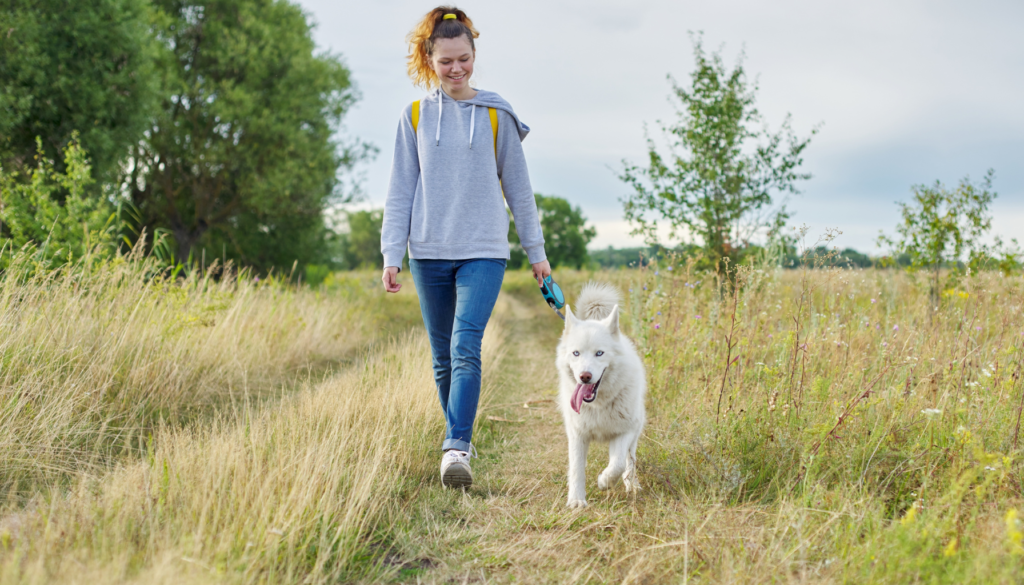Creating a daily routine for your dog isn’t just a nice-to-have—it’s essential for their health, happiness, and behavior. Dogs thrive on structure. When they know what to expect and when, they feel more secure and confident, which helps reduce anxiety and behavioral problems. Whether you’re raising a new puppy or refining your older dog’s habits, here’s how to build a routine that works for both of you.
Why a Routine Matters for Dogs
Dogs are creatures of habit. Establishing a daily rhythm:
- Reduces stress and anxiety
- Encourages healthy behaviors
- Supports training efforts
- Helps regulate digestion and bathroom habits
When dogs know when they’ll eat, go for walks, and get playtime, they’re less likely to act out due to boredom or uncertainty.
Start with a Morning Walk
The first thing your dog needs in the morning is to go outside. A 20–30-minute walk not only gives your dog a chance to relieve themselves but also helps burn off energy and sets a calm tone for the day.
Morning walk benefits:
- Stimulates the mind through sniffing and exploring
- Provides exercise to avoid hyperactivity later
- Builds a strong bond between you and your dog
If you can’t manage a long walk, even a quick outing for potty time followed by indoor play is better than nothing.
Feeding Time: Consistency is Key
Feeding your dog at the same time every day helps with:
- Digestion
- Predictable bathroom breaks
- Training (dogs are more motivated before meals)
Most adult dogs do well with two meals per day—morning and evening. Puppies may need 3–4 smaller meals spread out over the day.
Always provide fresh water and keep the food area clean to encourage healthy eating habits.
Bathroom Breaks Throughout the Day
The number of bathroom breaks your dog needs depends on their age, breed, size, and health, but a general rule is:
- Puppies: every 2–3 hours
- Adult dogs: every 4–6 hours
- Seniors: may need more frequent breaks
Stick to a regular schedule. Over time, your dog will learn when to expect breaks and will wait rather than having accidents indoors.
Midday Walks or Play Sessions
Dogs need both physical and mental stimulation. If you’re working from home or can come back during your lunch break, schedule a short walk or a game of fetch.
For busy owners, consider hiring a dog walker or using puzzle toys to keep your pup entertained during the day.
Ideas for midday activities:
- Tug-of-war
- Hide and seek with treats
- Chew toys or lick mats
- Obedience practice (sit, stay, come)
Evening Routine: Wind Down the Day
Evenings are a great time for bonding and relaxed activities:
- Go for a slower-paced walk
- Practice training commands
- Brush your dog’s coat
- Offer quiet cuddle time
Feeding dinner around the same time each evening helps with digestion and signals that bedtime is approaching. Avoid intense play right before sleep to help your dog settle down easily.
Don’t Forget Mental Stimulation
Dogs need more than just physical exercise. Mental activities can tire them out just as much:
- Food puzzles
- New commands or tricks
- Scent games (hide treats around the house)
Bored dogs often develop behavioral issues. Just 10–15 minutes of mental stimulation daily can make a big difference.
Weekend Flexibility (But Not Too Much)
It’s fine if your weekend schedule differs a bit, but try to keep key activities—like walks, meals, and bathroom breaks—within the same time window. Sudden changes can confuse your dog and disrupt their behavior.
Sample Daily Routine for an Adult Dog
Here’s a simple example to get you started:
| Time | Activity |
|---|---|
| 7:00 AM | Morning walk & potty break |
| 7:30 AM | Breakfast |
| 12:00 PM | Midday walk or play session |
| 6:00 PM | Dinner |
| 6:30 PM | Evening walk & potty break |
| 8:00 PM | Light play or cuddle time |
| 10:00 PM | Final potty break & bedtime |
Adjust this based on your lifestyle, your dog’s breed, and energy levels.
Final Thoughts: Keep It Realistic and Repeatable
The most important part of any routine is consistency. You don’t have to follow a strict schedule down to the minute, but keeping a reliable pattern will help your dog feel secure and behave better.
Remember to:
- Be patient when introducing a new routine
- Adjust based on your dog’s feedback and energy
- Celebrate small wins along the way
A well-structured day makes for a happier, healthier pup—and a more peaceful home for everyone.


